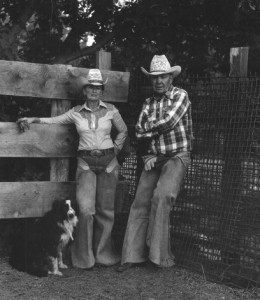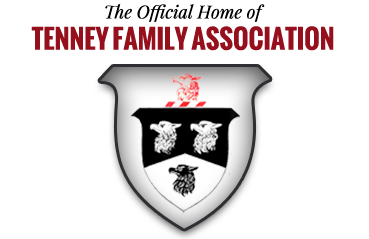Each year, as the National Day of the Cowboy approaches, members of the Board of Directors for the National Day of the Cowboy organization have the privilege of reviewing the many nominations submitted for its annual Cowboy Keeper Awards©. It is always an uplifting experience. The award is bestowed upon those who make a significant contribution to the preservation of cowboy culture and pioneer heritage. This year there were more nominations than ever, each one raising the bar for future nominees. Those selected to receive the award share, among other things, an impeccable character, a joyful work ethic, a broad range of talents and skills, a love for educating the public about cowboys, a sense of leadership, and a high degree of creativity. We are proud to name Sheila Carson, Waddie Mitchell, Ernie Sites, David Stoecklein, Bud Young, and husband wife team, Lyman & Alaire Tenney, as our 2015 Cowboy Keeper Award recipients.
Alaire & Lyman Tenney
 Lyman “C” Tenney, was born one of ten children on his family’s cattle ranch near Willcox, Arizona. His wife, Alaire, born in El Paso, Texas, was the daughter of Quarter Horse Association founder and AQHA Hall of Fame inductee, J.E. Browning. Together, Lyman and Alaire left a deep cowboy mark on the American Southwest and Australia.
Lyman “C” Tenney, was born one of ten children on his family’s cattle ranch near Willcox, Arizona. His wife, Alaire, born in El Paso, Texas, was the daughter of Quarter Horse Association founder and AQHA Hall of Fame inductee, J.E. Browning. Together, Lyman and Alaire left a deep cowboy mark on the American Southwest and Australia.
 Lyman started cowboying as soon as he could climb on a horse and spent 60 years in the saddle. At 15 he left home to cowboy on his own. “I wanted to see all the ranches I could and work for ‘em all.” In Arizona, he worked ranches from Big Chino to Ashfork, all the ranches on the Verde to Clarkdale, Cottonwood to Flagstaff, Mingus Mountain to Orme Ranch, Camp Verde to Dewey, Prescott to Crown King, down the Hassayampa and up Yarnell to Wickenburg. He worked cattle from Skull Valley to Williamson Valley, Cochise, Santa Cruz, and Pima Counties, the Graham, Winchester and Galiuros Mountains, the slopes of the Rincons, Whetstones, Huachucas, and more.
Lyman started cowboying as soon as he could climb on a horse and spent 60 years in the saddle. At 15 he left home to cowboy on his own. “I wanted to see all the ranches I could and work for ‘em all.” In Arizona, he worked ranches from Big Chino to Ashfork, all the ranches on the Verde to Clarkdale, Cottonwood to Flagstaff, Mingus Mountain to Orme Ranch, Camp Verde to Dewey, Prescott to Crown King, down the Hassayampa and up Yarnell to Wickenburg. He worked cattle from Skull Valley to Williamson Valley, Cochise, Santa Cruz, and Pima Counties, the Graham, Winchester and Galiuros Mountains, the slopes of the Rincons, Whetstones, Huachucas, and more.
He was a rodeo cowboy in the US and Australia, in saddle bronc, bareback and bull riding, and the timed events of steer roping, calf roping and team roping and a contestant the Prescott Rodeo for 22 years straight. During July 4th weekend, in 1941, he drove to Prescott to enter the rodeo. There he met 18 year-old cowgirl, Alaire Browning. The next summer, they decided to marry, and wed the day after he won the Dewey Saddle Bronc money.
Lyman went to work on the DK then the DuBois Ranch, until Alaire’s father bought the Bar HL south of Willcox. They worked the Bar HL from 1942 to 1951 when they bought the Muleshoe Ranch, selling it when drought forced them out. They moved to California, running 6,500 head of cattle in Imperial Valley. In 1963, Alaire, who was an expert cowhand, was badly injured when her horse tripped in a hole and rolled on her. She was unconscious for 77 hours. Recovery took far longer as she had to learn to walk again.
In 1966, Al Stansbury asked the Tenneys to run his ranch in Australia’s Northern Territory. Their accomplishments in Australia alone could fill volumes.
On the Woollogorang “Station,” in Australia, they managed the largest cattle operation they had ever run – 2,225 square miles, 1,650,000 acres, 10,000 head of cattle. It was 500 miles to the nearest grocery store and the closest rail point. Cattle drives to the railhead took 11 weeks. Lyman soon arranged to haul cattle by semi, shortening the drive to 18 days. One day, Lyman and son, Todd, gave a team roping demonstration at the Mount Isa Rodeo. It soon became a popular and widespread rodeo event. Lyman has since been called the “Father of Australian Team Roping,” because he introduced it to the continent.
Lyman and Alaire took part in an experimental program for Nelson Hunt, to domesticate water buffalo. Lyman helped form the CeeTeeGee Saddle Tree Company, making saddle trees for American-style roping saddles and hornless bronc riding saddles.
They staged the first roping school in Australia and helped establish the first rodeo club, started the Western Performance Horse Club and the Sierra Bonita Roping Club, trained Quarter horses and taught western riding.
In Aspley, they helped establish the Pine View Equestrian Center, became involved with the Australian Trail Horse Riders Association and helped establish the Australian National Riding Trail, said to be the longest continuous horse trail in the world.
They gave seminars and clinics teaching American style horsemanship and horse training, cutting and reining, as well as rodeo riding skills. Within a decade, they held over 100 schools in Australia and Tasmania.
They imported Quarter Horses, Appaloosas and Paints from the U.S. Lyman helped organize regional QHAs, and was a founding member of the Australian Quarter Mile Racing Association, a charter member of the National Cutting Horse Association of Australia, and organized and brought to fruition an NCHA Finals and Futurity. Alaire in turn, started the popular Ladies Cuttings in Australia. They formed the Western Australia Cutting Club.
They were a co-founders of the Paint Horse Association of Australia. Their Paint horse, Joeleo, was one of the founding sires and National Champion of the PHA of Australia; and the first horse inducted into the Australian PHA Hall of Fame.
 In 1971, Lyman produced the first American style rodeo in Brisbane. In 1973, at age 54, at the Roma Rodeo, he won 1st in calf roping and team roping and 2nd in steer roping, winning the All-Around Championship; the first time in Australian rodeo it was awarded to a contestant who only roped. In 1977, they formed the Albany Trail Riders Association. In 1979, Alaire was appointed head of the National Paint Horse Queen Committee, where she organized the Queen contest for the first PHAA National Show.
In 1971, Lyman produced the first American style rodeo in Brisbane. In 1973, at age 54, at the Roma Rodeo, he won 1st in calf roping and team roping and 2nd in steer roping, winning the All-Around Championship; the first time in Australian rodeo it was awarded to a contestant who only roped. In 1977, they formed the Albany Trail Riders Association. In 1979, Alaire was appointed head of the National Paint Horse Queen Committee, where she organized the Queen contest for the first PHAA National Show.
In 1980, they returned to Arizona. 1986 found them managing the 87 square mile DG Ranch outside Wickenburg. In 1994 they retired in Willcox, then moved back to Prescott. Lyman was inducted into the Arizona Living Pioneer Hall of Fame. Alaire, who ranched, roped cattle; team roped, and taught roping and riding right beside her husband, passed away in 2008. Lyman passed in 2009. Few, if any, men or women have cowboyed as extensively in the American Southwest as Lyman and Alaire Tenney, and no other husband and wife team has done more to proliferate the cowboy culture in Australia.

